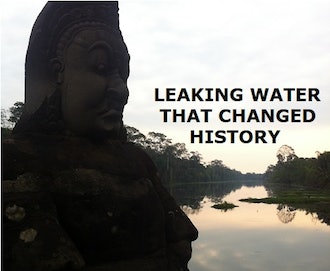When generating content for my website (swimmingpoolsteve.com), one of my requirements was to create compelling and unique articles that I, personally, would find interesting. For example: What’s the most iconic swimming pool failure in history? Is there even such a thing? At first I was thinking along the lines of perhaps a famous person who built an extravagant pool only to have it fail or the contractor to go belly up (or missing) during the construction phase. What I ended up finding was so, so much more interesting than that.


To help you picture this better, just imagine a great city filled with 1,000 stone temples ranging from modest to gargantuan, set in an area of the world that never gets cold and experiences alternating seasons of drought and monsoon. Right in the middle of the city is the Angkor Wat temple, which is surrounded by water on all sides.
It is a densely populated, thriving city for a reason — the ancient builders and owners of Angkor had a very advanced (for the time) understanding of how to manipulate and store water. In an area that is flooded half the year and in drought the other half, the ability to control water literally meant the difference between life and death. When the temperature is 104 degrees Fahrenheit with 70% to 100% humidity, you are not going to make it for very long without water. And your massive stores of water must remain clean to see you through the long drought season. This was the magic of Angkor and the reason why people flocked here — to live in the relative security of a place that had access to water all year long.


During the dry season the groundwater would not be sufficient to maintain the desired moisture level in the sand, so a massive reservoir, or moat, really, exists on all sides of the Angkor complex. This moat collects all runoff from the temple grounds and protects the sand from drying out, even during the hottest and driest parts of the year. While building on a swamp is not ideal, how else could you build in an area with such seasonal variation? In essence, Angkor Wat was built like a ship, floating on a swampy, sandy ocean. This amazing feat of 1,000-year-old engineering exists even to this day, more or less unchanged, and should continue long into the future if the ground water tables are not drastically changed by unrestricted development.

The system of reservoirs, embankments, moats, dykes and dams stretched over an area of almost 600 square miles. This massive water containment system, easily the largest and most advanced in the world at the time, allowed the city of Angkor to flourish from its start in 800 AD up until the 1300's. Over time as the population of Angkor grew and the water system grew more and more complex, they passed a critical stage of no return where the size and complexity of the system outgrew the ability of the people residing there to maintain and repair these systems. By the time the floods of the 1300's came, the city of Angkor was already straining the aging water systems that sustained their existence.
Periods of intense flooding, the likes of which had not been experienced in that area of the world for hundreds of years, brought about the beginning of the end for Angkor. Researchers conclude that unusually high water tables caused ditches, rivers and reservoirs to overflow. There were attempts to shunt the flow of water but the volumes could not be controlled. Moats overflowed, fields flooded, rivers widened and found new paths of least resistance, and the system that had brought a million people together finally broke.
Despite manpower in the hundreds of thousands, and resources and riches beyond imagination (such as Preah Khan temple which contained over 60 tons of gold, worth over three billion dollars by modern standards) there was no way to fix the damage done by flooding and ultimately entire vast sections of the network were damaged beyond repair and abandoned. Even attempts to fix parts of the complex hydraulic system that had taken hundreds of years to build failed due to the size and complexity of the system, and the state of deterioration from both age as well as flood damage.

Two periods of unprecedented drought, each 20 years long, doomed the remaining Angkor survivors in the 1400's. By 1500 only a skeleton crew of devoted monks remained to honor the holy grounds of Angkor Wat. All others had died, been captured or fled the area in search of stable water. Eventually the entire landscape of Angkor became lost to the jungle, overgrown and deteriorating with the earth slowly reclaiming the resources back into the landscape, until the late 1800's when a French explorer stumbled onto the apparent ruins of some great city in the middle of a dangerous and sweltering Asian jungle. There he found the ruins of Angkor Wat — a great civilization brought to its knees and destroyed by the worst swimming pool leak in history.

Steve Goodale is a second generation swimming pool expert located in Ontario, Canada. You can learn more about Steve, as well as swimming pool construction, maintenance and repair from his website: SwimmingPoolSteve.com.












































